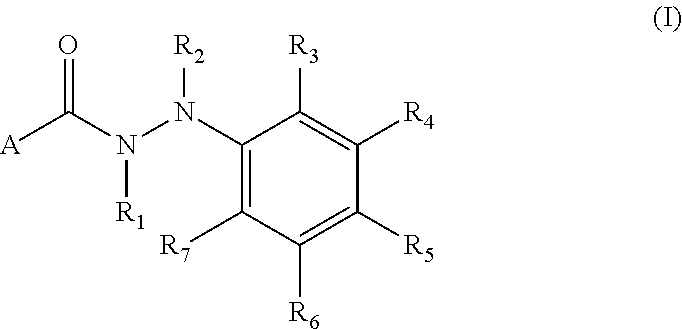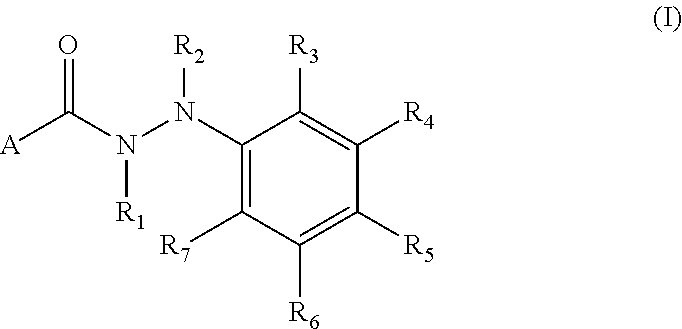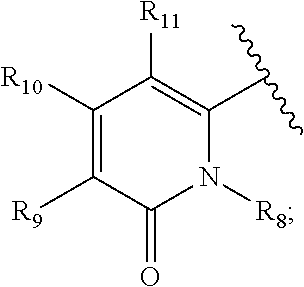Arylhydrazides containing a 2-pyridone moiety as selective antibacterial agents
a technology of arylhydrazide and pyridone, which is applied in the field of new antibacterial agents, can solve the problems of high healthcare cost, and increased morbidity, mortality and duration of hospital stay
- Summary
- Abstract
- Description
- Claims
- Application Information
AI Technical Summary
Benefits of technology
Problems solved by technology
Method used
Image
Examples
example 1
6-oxo-1,6-dihydro-pyridine-2-carboxylic acid N′-(4-fluoro-phenyl)-hydrazide
[0423]620 mg (3.7 mmol, 1 equiv.) of 1-methyl-6-oxo-1,6-dihydro-pyridine-2-carboxylic acid were dissolved in 5 mL of dry dichloromethane and to it DIPEA (3 equiv.) and HATU (1 equiv.) were added. After 10 min stirring at 0° C., (4-fluorophenyl)-hydrazine hydrochloride (1.5 equiv.) was added. The reaction mixture was allowed to stir overnight at room temperature under nitrogen atmosphere. After the completion of the reaction, solvent was removed and the residue was washed with brine (two times, 5 mL) and extracted with dichloromethane (three times, 10 mL). The collected organic phase was dried over anhydrous Na2SO4, and concentrated under reduced pressure. The crude product was purified by column chromatography to obtain 200 mg of pure title compound (19%).
[0424]1H NMR (500 MHz, CDCl3) δ: 3.4 (s, 3H), 4.39-4.44 (m, 2H), 6.49-6.50 (m, 1H), 6.55-6.57 (m, 1H), 6.82-6.85 (m, 2H), 7.02-7.06 (m, 2H), 7.48-7.50 (m, 1...
example 2
-oxo-1,6-dihydro-pyridine-2-carboxylic acid N′-(4-fluoro-phenyl)-hydrazide
Step 1: 6-Oxo-1, 6-dihydro-pyridine-2-carboxylic acid ethyl ester
[0425]
[0426]850 mg (6.11 mmol) of 6-oxo-1,6-dihydro-pyridine-2-carboxylic acid was dissolved in 14 mL of dry ethanol and to it 0.75 mL of concentrated H2SO4 was added slowly under ice-cooled conditions. The reaction mixture was allowed to stir overnight at reflux under nitrogen atmosphere. After the completion of reaction, the reaction mixture was concentrated under vacuum. Saturated NaHCO3 solution was added to the reaction mixture until the pH of solution was 8. Then it was extracted with dichloromethane (three times, 15 mL) and the collected organic phase was dried over anhydrous Na2SO4, concentrated under vacuum, yielding 800 mg (78%) of crude title compound. LC-MS: 168.2 (M+H).
Step 2: 1-Ethyl-6-oxo-1, 6-dihydro-pyridine-2-carboxylic acid ethyl ester
[0427]
[0428]To a stirring solution of 500 mg (2.99 mmol) of 6-oxo-1,6-dihydro-pyridine-2-carbo...
example 3
oxyethyl)-6-oxo-1,6-dihydro-pyridine-2-carboxylic acid N′-(4-fluorophenyl)-hydrazide
Step 1: 1-(2-methoxyethyl)-6-oxo-1,6-dihydro-pyridine-2-carboxylic acid ethyl ester
[0435]
[0436]To a stirring solution of 200 mg (1.19 mmol) of 6-oxo-1,6-dihydro-pyridine-2-carboxylic acid ethyl ester (prepared as in Step 1 of Example 1) in 6 mL of dry DMF, 330 mg (2.39 mmol) of K2CO3 and 39 mg (0.119 mmol) of TBAB were added. The reaction mixture was allowed to stir for 10 min at room temperature. The reaction mixture was cooled at 0° C. and to it 0.22 mL (2.39 mmol) of 1-bromo-2-methoxyethane were added. After the completion of reaction, the reaction mixture was quenched with cold water and extracted with ethyl acetate (three times, 15 mL). The collected organic layer was dried over anhydrous Na2SO4 and concentrated under vacuum. The crude reaction mixture was purified by column chromatography (4% ethyl acetate in hexane) to yield 65 mg (24%) of title compound. LC-MS: 226.4 (M+H).
Step 2: 1-(2-methox...
PUM
 Login to View More
Login to View More Abstract
Description
Claims
Application Information
 Login to View More
Login to View More - R&D
- Intellectual Property
- Life Sciences
- Materials
- Tech Scout
- Unparalleled Data Quality
- Higher Quality Content
- 60% Fewer Hallucinations
Browse by: Latest US Patents, China's latest patents, Technical Efficacy Thesaurus, Application Domain, Technology Topic, Popular Technical Reports.
© 2025 PatSnap. All rights reserved.Legal|Privacy policy|Modern Slavery Act Transparency Statement|Sitemap|About US| Contact US: help@patsnap.com



